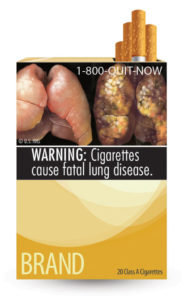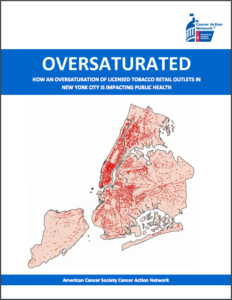Welcome to CounterTobacco.org’s “News and Research Roundup!” Each month we post a summary of the latest research, reports, and news stories on counteracting tobacco product sales and marketing at the point of sale (POS). Keeping up with what’s happening in the POS movement all across the country can help you choose policies and strategies that work best for your community. New research can help provide support for your work and evidence for the importance of the “War in the Store.” Have a story you don’t want us to miss? E-mail it to us!
New Research
Cigarette Packaging and Labels

- Public attitudes toward larger cigarette pack warnings: Results from a nationally representative U.S. sample, PLoS One
- This nationally representative survey of over 5,000 U.S. adults found that most adults (72%) had favorable attitudes towards larger warning labels on cigarette packages. For warning labels that covered 25% of the pack, 78.2% of adults and 75.2% of smokers were supportive. For warning labels that covered 50% of the pack, 70% of adults and 58.4% of smokers were supportive, and for warning labels that covered 75% of the pack, 67.9% of adults and 61% of smokers were supportive.
- News story: Broad support exists for larger warnings on cigarette packs, EurekAlert!
- Learn more about point of sale health warnings.
- Which cigarettes do Americans think are safer? A population-based analysis with wave 1 of the PATH study, Tobacco Control
- Researchers analyzed 3 sub-brands for whether their users thought they “might be less harmful,” “no different,” or “more harmful” that other brands of cigarettes. Eleven sub-brands had at least 10% of their users report that they might be less harmful, and all of these brands had been marketed with the terms “light” or “mild” prior to implementation of the 2009 Family Smoking and Tobacco Prevention Act prohibition on such descriptors, or they were marked with the terms “additive-free” or “natural.” Two-thirds of American Sprit Mellow and 55% of American Spirit Full-Bodied smokers thought their brand might be less harmful.
- Editorial: Natural American Spirit Brand Marketing Casts Health Halo Around Smoking, American Journal of Public Health
Tobacco Use Disparities
- Adolescent Tobacco Use in Urban Versus Rural Areas of the United States: The Influence of Tobacco Control Policy Environments, Journal of Adolescent Health
- Tobacco use has traditionally been higher among adolescents and adults living in rural areas of the United States. The study analyzed data from the National Youth Tobacco Survey from 2011-2014 and found higher rates of current cigarette, smokeless tobacco, multiple tobacco product, and any tobacco use among rural youth. Sociodemographics, cigarette taxes, and exposure to tobacco advertisements predicted 40% of the disparity found in tobacco use rates between urban and rural adolescents However, e-cigarette use among urban adolescents increased from .82% in 2011 to 8.72% in 2014, changing traditional patterns of tobacco use.
- Tobacco Product Use Among Lesbian, Gay, and Bisexual Adolescents, Pediatrics
- News Story: Lesbian and bisexual girls more likely than other teens to smoke, Reuters
Product Classification
- Changes in the Mass-merchandise Cigar Market since the Tobacco Control Act, Tobacco Regulatory Science

LCCs with nondescript or “concept” flavors - While the 2009 Tobacco Control Act banned flavored cigarettes, and required cigarettes to be sold in packs of at least 20, no such regulations were put in place for cigars. Researchers tracked sales data from convenience stores from 2008 to 2015, and they found that cigar companies may have leveraged the newly prohibited features in cigarettes to maximize their profits in other products. Flavored cigar sales increased by nearly 50% since 2008, and now make up over half of the cigar market. Fruit remains the most popular flavor group, but the sale of nondescript flavors such as “Jazz” and “Green” has grown substantially. Inexpensive 2- and 3-packs made up less than 1% of cigar sales in 2008, but by 2015 this packaging style held 40% of the market share. Black & Mild and Swisher Sweets dominate the convenience store channel and together are responsible for nearly 60% of total mass-merchandise cigar sales.
- Flavour chemicals in a sample of non-cigarette tobacco products without explicit flavor names sold in New York City in 2015, Tobacco Control
- An analysis of 16 tobacco products purchased in NYC in 2015 that did not have explicit flavor names (but were labeled with descriptors such as “blue” or “royale”) found that 14 out of the 16 had flavor chemical levels higher than products labeled with a flavor (such as “peach” or “grape”). The researchers conclude that the tobacco industry has renamed flavored products to avoid identifying them as such. They also suggest that the FDA require that all tobacco products indicate when flavorings are present above a set level, which local jurisdictions could then use to enforce sales restrictions on flavored tobacco products.
- Learn more about flavored tobacco products.
E-Cigarettes
-

E-cig ads at the POS Exposure to advertising and perception, interest, and use of e-cigarettes among adolescents: findings from the US National Youth Tobacco Survey, Perspectives in Public Health
- Exposure to e-cigarette advertisements in the retail setting was associated with higher likelihood of current e-cigarettes use and perception of reduced harmfulness compared to regular cigarettes.
Learn more about e-cigarettes at the point of sale.
- Exposure to e-cigarette advertisements in the retail setting was associated with higher likelihood of current e-cigarettes use and perception of reduced harmfulness compared to regular cigarettes.
- Associate of attitudes towards electronic cigarettes with advertisement exposure and social determinants: a cross sectional study, Tobacco Induced Diseases
- This study surveying 6037 students at a large Midwestern university found that 35.7% of students surveyed had seen an advertisement for e-cigarettes at a retail store. This exposure was associated with lower perceived addictiveness of e-cigarettes and with increased belief in acceptability of use in bars, stores, at work, in class, or in dorms. In addition, being white, male, a smoker, having a mother who smoked, and Internet advertisement exposure were associated with lower perceived harm of e-cigarettes. Researchers suggest that e-cigarette advertisements contribute to normalization of e-cigarette use.
- Sales of Nicotine-Containing Electronic Cigarette Products: United States, 2015, American Journal of Public Health
- Initiation of Electronic Cigarettes Use by Age Among Youth in the U.S., American Journal of Preventive Medicine
 New Reports
New Reports
- Oversaturated: How an oversaturation of licensed tobacco retail outlets in New York City is Impacting Public Health, American Cancer Society
- News story: NYC has more tobacco retail locations than Starbucks, pizzerias, report says, AM New York
Industry News
- Three More Cigarette Makers Raise Prices, CSP Daily News
- Demand for New Heat-Not-Burn Products Outpacing Supply, Convenience Store News
- Tobacco’s Alternate Universe: 2020, CSP Magazine
- Philip Morris’ IQOS Less Harmful as per Recent Research, Nasdaq
- A Combustible Matter: Flavor innovation is boosting the cigar category, grabbing both shopper and FDA attention, CSP Magazine
- FDA Proposed Smokeless Product Standard, Convenience Store Decisions
- PMI Submits Pre-Market Application for Heat-Not-Burn, Convenience Store News
- Reynolds enters FDA modified-risk regulatory gauntlet for 6 Camel Snus styles, Winston-Salem Journal
- The Next C-store Tobacco Competitor: Manufacturers?, Convenience Store News
POS Policy in the Media
- Poor, minority neighborhoods have more tobacco-selling shops per capita, Reuters
- Most remaining smokers in US have low socioeconomic status, Science Daily
- Baltimore County officials say enforcement, education have greatly reduced tobacco sales to minors, Baltimore Sun
- Plain packaging for cigarettes to begin in September, Irish Times
- ADA, others ask Congress to reject tobacco policy riders, keep CDC funding, ADA News
- Henderson County asks state for more control over smoking regulations, WLOS
Pricing
- De Blasio Backs Efforts to Reduce Tobacco Use Among New Yorkers, New York Times
- Lawmakers consider taxes on vaping and e-cigarettes, KING 5
- Tobacco prices to change throughout DOD, DVIDS Hub
- California Today: Thwarting the Tobacco Tax, New York Times

Flavored Tobacco
- San Francisco Seek to Ban the Sale of Menthol Cigarettes, Flavored Tobacco Products, California Healthline
- Tobacco Companies Sweeten The Brand to Attract Youth, WXPR
- California targets candy-flavored tobacco as teen ‘gateway’ to cigarette smoking, Sacramento Bee
- AAP, others urge FDA to prohibit all flavored tobacco products, SmartBrief
- Board of Health votes new tobacco sales rules, Daily Times Chronicle
- UTHealth researchers find e-cigarette flavors linked to use in youth and young adults, EurekAlert
- Oakland Officials Want to Ban Flavored Blunt Wrappers, Two-Pack Cigars, And Vape Juice, East Bay Express
- Government of Canada finalizes ban on menthol in most tobacco products, Health Canada
Tobacco 21
- Tobacco age now 21 in Lane County, KVAL
- Cancer Activists Push Bill to Hike Legal Age to Buy Tobacco, Cape Cod NewsCenter
- Citing health risk, Senate approves raising Oregon tobacco age to 21, Oregon Live
- Smoking age hiked to 21 in Williston Park, The Island Now
- Bill filed to raise minimum age to buy tobacco products in NC, WNCT
- Maine Minimum Tobacco Purchasing Age Increased Proposed, HalfWheel
- Vapor shop owners and doctors go head-to-head during hearing to raise smoking age to 21, Dallas News
- Should Washington raise age for cigarettes, vape products to 21? House tax panel votes yes, Spokesman-Review
- Aspen considers raising tobacco, e-cigs age to 21, Aspen Times
Find more stories in last month’s News and Research Roundup.
Know of a story that we missed? Email us, and we’ll be sure to include it in next month’s roundup!


